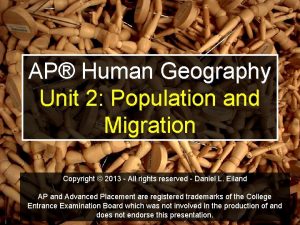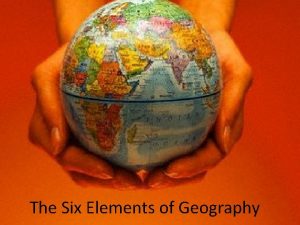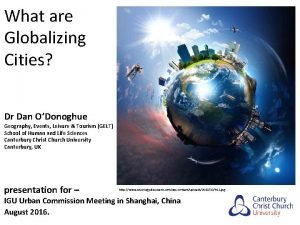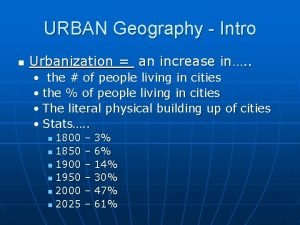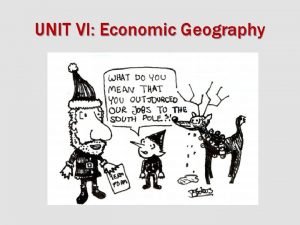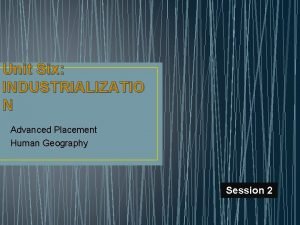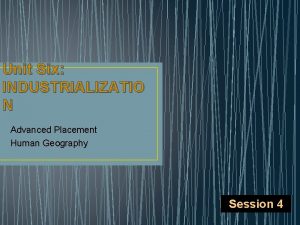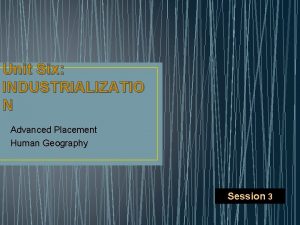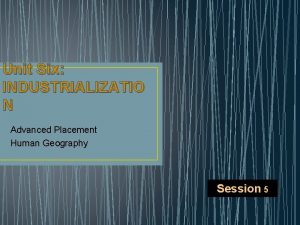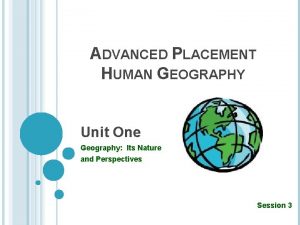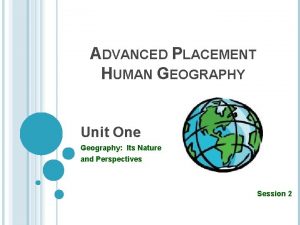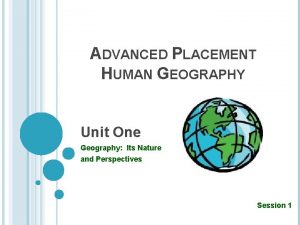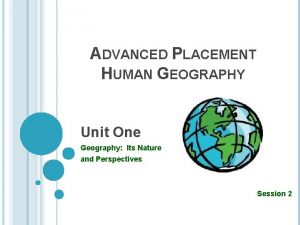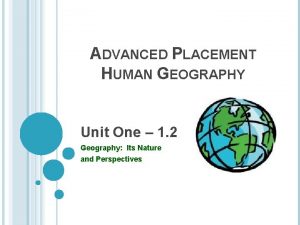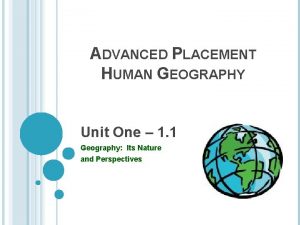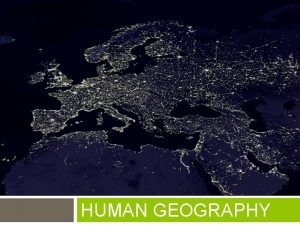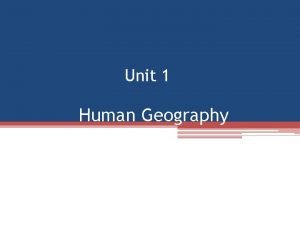Unit Six INDUSTRIALIZATIO N Advanced Placement Human Geography






















































- Slides: 54

Unit Six: INDUSTRIALIZATIO N Advanced Placement Human Geography Session 6

GLOBAL INEQUALITIES

The Industrial Revolution set in motion dramatic global inequalities that exist among people and nations today.

Today… • An increasingly integrated global economy provides challenges for all countries, despite their levels of development. • The problems for more developed countries generally differ from those of less developed countries.

CHALLENGES FOR MORE DEVELOPED COUNTRIES

Challenges for More Developed Countries • An important challenge for more developed regions is the protection of their markets from new competitors. • This challenge is increasing since competition now occurs more frequently within regional trading blocs, or conglomerations of trade among countries within a region.

Impact of Trading Blocs • The three most important trading blocs are: • North America • The European Union • East Asia

North America Important Trading Bloc Since 1994, NAFTA countries have negotiated with other Latin American countries to extend the trading bloc to new areas of the Western Hemisphere.

The European Union (EU) Important Trading Bloc • Most trade barriers have been eliminated among the members of the EU. • Even European nations that are not EU member-states depend heavily on trade with members.

East Asia • No formal organization of states exists in East Asia. • However, Japanese companies play leading roles in the economies of the countries of that region. Important Trading Bloc East Asia

East Asia Important Trading Bloc • The rapid economic development of many Pacific Rim countries has created a strengthening trade bloc in East Asia in spite of tensions among countries in this region.

Transnational Corporations • Transnational corporations operate factories in countries other than the ones in which they are headquartered. • Most transnational corporations are also conglomerate corporations comprised of many smaller firms that support the overall industry. • Most transnational corporations are headquartered in the U. S. , but other are located in Japan or Europe.

Disparities within Trading Blocs European Union: • Industrialization is concentrated in Germany, France, and the United Kingdom. • Even within those individual countries some areas are more industrialized and richer than others.

Disparities within Trading Blocs European Union: • Example of disparity: In France, wealth and industry are concentrated around Paris. • Example of disparity: The eastern part of Germany, formerly communist, lags behind the rest of Germany.

Disparities within Trading Blocs • Example: Within the NAFTA countries, Mexico’s economy lags behind those of the U. S. and Canada.

Deindustrialization

Deindustrialization • Deindustrialization refers to the decline in employment in the manufacturing sector of the economy. • Deindustrialization is commonly found in more developed countries.

Deindustrialization • Generally, the number of jobs in the service or tertiary sector increases as the percentage of jobs in industry decreases.

Deindustrialization • Deindustrialization is particular evident in: • The United States • Europe • Japan • The economies of the Four Tigers

Deindustrialization: A Cause for Concern • Some suggest that deindustrialization is the result of the globalization of markets as trade between advanced economies and the developing world has grown.

Deindustrialization: A Cause for Concern • Critics believe that the fast growth of laborintensive manufacturing industries in LDCs is displacing the jobs of workers in advanced economies.

Deindustrialization: Some Optimism • Some believe that the adjustments between industrial and service sectors will work themselves through without interference. • Advances in the service sector, rather than in the manufacturing sector, are likely to encourage rising standards of living in advanced economies.

CHALLENGES FOR LESS DEVELOPED COUNTRIES

Industrial development not only lifts the value of exports, it generates money to buy other products.

Problems Encountered by LDCs • Distance from markets • Inadequate infrastructure • Competition with existing manufacturers in other countries

Less developed countries face the challenge of reducing the disparities between their economies and those of more developed countries.

Distance from Markets • Wealthy consumers in MDCs are generally far away, so industrializing countries have had to invest scarce resources in constructing and subsidizing transportation facilities such as: • airports • docks • ships

Inadequate infrastructur e • Support services for industrial development are often lacking in LDCs. • These services include: • • transportation communications equipment production fewer schools and universities

Competition with Existing Manufacturers in Other Countries • The control exerted by transnational corporations headquartered in MDCs, but doing business globally, is a problem for LDCs.

Competition with Existing Manufacturers in Other Countries Transnational corporations have used low-cost labor in LDCs but have kept highly skilled jobs in the MDCs, a phenomenon known as the international division of labor.

• The international division of labor is a process that: Competition with Existing Manufacturers in Other Countries • keeps global inequalities in place • discourages new industries from developing in LDCs • prevents wealth from flowing from MDCs to LDCs

INDUSTRIALIZATION AND THE ENVIRONMENT

Industrialization and the Environment As a result of the Industrial Revolution, coal replaced wood as the leading energy source in North America and Western Europe.

Industrialization and the Environment • The change from wood to coal relieved the environmental pressure of deforestation. • However, it increased the likelihood that coal, and eventually petroleum and natural gas, would be depleted as natural resources.

Industrialization and the Environment Population growth has added to the problem but energy use in MDCs is far greater than it is in LDCs.

Industrialization and the Environment • Fossil fuels – including coal, petroleum, and natural gas – are residues of plants and animals that were buried millions of years ago. • The world faces an energy problem because fossil fuels, especially petroleum, are rapidly being depleted.

Fossil Fuel Reserves • Energy deposits that have been discovered are called proven reserves. • We do not know how many potential (undiscovered) reserves there are. • Petroleum is being consumed at a more rapid rate than it is being found.

TOP CONSUMERS OF OIL Country Usage United States 20, 700, 000 bbl/day China 6, 534, 000 bbl/day Japan 5, 578, 000 bbl/day Germany 2, 650, 000 bbl/day Russia 2, 500, 000 bbl/day India 2, 450, 000 bbl/day Canada 2, 294, 000 bbl/day South Korea 2, 149, 000 bbl/day Brazil 2, 100, 000 bbl/day France 1, 970, 000 bbl/day Source: Nation. Master. com

Consumption of Fossil Fuels MDCs, with about 25% of the world’s population, consume about 75% of the world’s fossil fuels.

Consumption of Fossil Fuels As countries with large populations, such as China and India, develop industries, their share of the world’s consumption of energy is increasing.

INDUSTRIAL POLLUTION

Industrial products have greatly added to the overall pollution of air, water, and land resources on Earth.

Global Warming • Global warming is the increase in earth’s temperature caused primarily by the burning of fossil fuels. • The greenhouse effect is an anticipated warming of earth’s surface that could melt the polar icecaps and raise the level of the oceans enough to destroy coastal cities.

Acid Rain • Another by-product of air pollution is acid rain, which forms when sulfur dioxide and nitrogen oxides are released into the atmosphere by burning fossil fuels. • Pollutants eventually make their way into lakes and streams.

Acid Rain • Results include: • corrosion of buildings and monuments • stunted growth of forests • death of fish • loss of crops

SUSTAINABLE DEVELOPMENT

Sustainable Development The basic premise of sustainable development is that people living today should not impair the ability of future generations to meet their needs.

Sustainable Development • Irreparable harm to the environment would compromise the earth’s future. • Many critics believe that the pace of economic development today is no longer sustainable, despite the fact that natural resources still abound.

Possible Solutions to Environmental Problems Humans may respond to environmental problems in many ways, including the following: • prevention • technological change • mitigation • compensation

Prevention • Some government policies have encouraged destruction of the environment (e. g. cheap gasoline). • The one-child policy in China is an example of prevention of over-use of natural resources through limiting population growth.

• Technological possibilities include: Technologica l Change • installing pollutioncapturing filters for industrial runoff • recycling industrial waste

Mitigation • Damage may be undone or reduced once it has occurred. • Example: Chemical spills may be cleaned up.

Compensatio n • Political bodies may negotiate compensation for those negatively impacted by industrial wastes. • Example: A company whose chemical wastes have resulted in illness and/or death among workers may be held legally responsible for damages.

Key Terms and Concepts to Review for this Session • • • Global inequalities Global economy Trading blocs Trade barriers Transnational corporations • Conglomerate corporations • Deindustrialization • Infrastructure • International division of labor • Fossil fuels • Global warming • Greenhouse effect • Acid rain • Sustainable development
 Frq format ap human geography
Frq format ap human geography 5 themes of geography ap human geography
5 themes of geography ap human geography Proruption ap human geography
Proruption ap human geography Advanced placement incentive program
Advanced placement incentive program Advanced placement courses
Advanced placement courses Human development index definition ap human geography
Human development index definition ap human geography Ap human
Ap human Popular culture ap human geography
Popular culture ap human geography Newly industrialized countries ap human geography
Newly industrialized countries ap human geography Cultural landscape ap human geography example
Cultural landscape ap human geography example What is placelessness in ap human geography
What is placelessness in ap human geography Isogloss definition ap human geography
Isogloss definition ap human geography Ap human geography unit 2
Ap human geography unit 2 Flows definition ap human geography unit 1
Flows definition ap human geography unit 1 Neo malthusians definition ap human geography
Neo malthusians definition ap human geography The number of principal views are
The number of principal views are Sqa advanced higher geography understanding standards
Sqa advanced higher geography understanding standards Advanced higher english understanding standards
Advanced higher english understanding standards A polygon with six congruent sides and six congruent angles
A polygon with six congruent sides and six congruent angles The 6 essential elements of geography
The 6 essential elements of geography Interdependence
Interdependence 6 elements of geography
6 elements of geography Six elements of geography
Six elements of geography Six elements of geography
Six elements of geography Six essential elements of geography definitions
Six essential elements of geography definitions Unit 6 review questions
Unit 6 review questions Advanced human trafficking #3271 test answers
Advanced human trafficking #3271 test answers 3271 advanced human trafficking
3271 advanced human trafficking 3271 advanced human trafficking
3271 advanced human trafficking Unit 4 crime and punishment
Unit 4 crime and punishment Wjec criminology unit 4 revision
Wjec criminology unit 4 revision Advanced higher biology
Advanced higher biology Higher biology photosynthesis questions
Higher biology photosynthesis questions Higher biology unit 1
Higher biology unit 1 What is sex linkage in biology
What is sex linkage in biology Human resources six sigma
Human resources six sigma Whats round robin
Whats round robin Ap human geography chapter 11 vocab
Ap human geography chapter 11 vocab Topographic map definition ap human geography
Topographic map definition ap human geography Alpha beta gamma cities ap human geography
Alpha beta gamma cities ap human geography Anocracy ap human geography definition
Anocracy ap human geography definition Webers least cost theory
Webers least cost theory Bid rent theory model
Bid rent theory model Thnen
Thnen Von thunen’s model definition ap human geography
Von thunen’s model definition ap human geography Township and range ap human geography
Township and range ap human geography Bid rent theory example
Bid rent theory example Clustered definition ap human geography
Clustered definition ap human geography Central place theory assumptions
Central place theory assumptions Mdcs dubai
Mdcs dubai Modernization model ap human geography
Modernization model ap human geography Nation state
Nation state Definition of geography
Definition of geography Urban sprawl aphug
Urban sprawl aphug Compact states examples
Compact states examples












